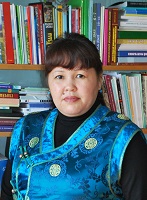Buluk as the original name of arzhaan Kundustug
DOI:
https://doi.org/10.25178/nit.2018.3.10Keywords:
toponymics; Tuva; toponym; microtoponym; Tuvan language; arzhaan; holy spring; Eerbek; Biche-Bayan-Kol; Buluk; KundustugAbstract
This paper investigates the original name of the holy spring Buluk that is located on the right bank of the Yenisei river, not far from the city of Kyzyl. In 2004, the holy spring was renamed Kundustug, although its original name had been Buluk.
We provide vocabulary definitions of ‘buluk’ from etymological, toponymical and other dictionaries of Tuvan and counterpoise them with interpretations obtained from local population surveyed in 2011-2012. The author points out the connection between geographical features and the name of holy spring Buluk and analyses written and cartographic documentary sources that confirms the historical name of holy spring. The name reflects the natural features of the arzhaan, which does not freeze completely in winters, and some springs form icing which keeps increasing until spring.
The paper also examines derivative micro-toponyms. The location on the north side of the holy spring is called Buluk kyry (Above Buluk), while a place up the Yenisei river called Buluk ustu (Upstream Buluk) and down the river, Buluk Adaa (Downstream Buluk). The area of holy spring Buluk has always been and remains part of the Eerbek village, which, in its turn, currently is part of Kyzyl kozhuun.
The article concludes by emphasizing the importance of preserving the original names of geographical objects, which contain unique cultural and historical information. At the moment, the village residents of Eerbek and shepherds of Biche Bayan-Kol are working on restoration of native historical name of holy spring.
References
Federal’nyi zakon ot 18 dekabria 1997 g. N 152-FZ "O naimenovaniiakh geograficheskikh ob”ektov" (s izmeneniiami i dopolneniiami) [The federal law of December 18, 1997 no. 152-FZ "About names of geographical objects" (with changes and additions)]. Sistema Garant [online] Available at: http://base.garant.ru/12106462/ (access date: 10.07.2018) (In Russ.).
Zhiznʹ zhivotnykh [Life of animals] (1989) : in 7 vols / Editorial board: V. E. Sokolov (editor-in-chief) et al. 2nd ed. Moscow, Prosveshchenie. Vol. 7. Mlekopitaiushchie [Mammals] / ed. by V. E. Sokolov. 558 p. (In Russ.).
Carruthers, D. (2003) Nevedomaia Mongoliia. Vol. 1. Uriankhaiskii krai [Unknown Mongolia. Vol. 1. Uryankhaysky krai]. Kyzyl, Tuvinskoe knizhnoe izd-vo. 341 p. (In Russ.)
Katanov, N. F. (2011) Ocherki Uriankhaiskoi zemli: Dnevnik puteshestviia, ispolnennogo v 1889 godu po porucheniiu Imperatorskoi Akademii Nauk i Imperatorskogo Russkogo Geograficheskogo Obshchestva [Sketches of the Uryankhaysky krai: The diary of the journey made in 1889 at the request of Imperial Academy of Sciences and the Imperial Russian Geographical Society]. Kyzyl, OOO «Kooperativ «Zhurnalist». 384 p. (In Russ.)
Mannai-ool, M. Х. (2004) Tuvintsy: Proiskhozhdenie i formirovanie etnosa [Tuvans: Origin and formation of an ethnicity]. Novosibirsk, Nauka Publ. 166 p. (In Russ.).
Mintslova, K. D. (1993) Dalekii krai: Puteshestvie po Uriankhaiskoi zemle [Strange lands: Travels in the Uryankhaysky krai]. Kyzyl, Novosti Tuvy. 128 p. (In Russ.)
Ondar, B. K. (2007) Toponimicheskii slovarʹ Tuvy [A Toponymical dictionary of Tuva]. 2nd ed. Kyzyl, Tuvinskoe knizhnoe izd-vo. 550 p. (In Russ.)
Pivtorak, V. (1960) O karte Tuvy [On a map of Tuva]. Tuvinskaia pravda, 14 May, p. 3. (In Russ.)
Polozhenie «O statuse arzhaana «Kundustug» [Regulation "On the status of an arzhaan of "Kundustug"] (2004). Vesti Kyzyla, no. 34, p. 3. (In Russ.)
Potanin, G. N. (1883) Ocherki Severo-Zapadnoi Mongolii [Sketches of Northwest Mongolia]. St. Peterburg, Tipografiia V. Kirshbauma. Vol. IV. 2196 p. (In Russ.)
Sat, Sh. Ch. (1970) Zametki po toponimike [Notes on toponymics]. Tuvinskaia pravda, 20 September, p. 4. (In Russ.)
Safʹianov, I. G. (2012) Tuva v proshlom [Tuva in the past]: in 2 vols. Moscow. Vol. 1. Хudozhestvennoe tvorchestvo tuvinskogo naroda. Fotoarkhiv: K 90-letiiu Tuvinskoi Narodnoi Respubliki [Art of the Tuvan people. Photoarchive: To the 90 anniversary of the Tuva People's Republic]. 232 p. (In Russ.)
Tatarintsev, B. I. (2000) Etimologicheskii slovarʹ tuvinskogo iazyka [Etymological dictionary of the Tuva language]. Novosibirsk, Nauka Publ. Vol. 1. A–B. 341 p. (In Russ.)
Tolkovyi slovarʹ tuvinskogo iazyka [Explanatory dictionary of the Tuva language]. (2003) / ed. by D. A. Mongush. Novosibirsk, Nauka Publ. Vol. 1. A-I. 599 p. (In Russ.)
Tuvinsko-russkii slovarʹ [A Tuvan-Russian dictionary]. (1968) / ed. by E. R. Tenisheva. Moscow, Sovetskaia entsiklopediia. 646 p. (In Russ.)
Uinukai, V. (2003) Kyzyldy dolgandyr chүү baryl? [What lies in vicinities of Kyzyl?]. Tyva Respublika, no. 30, p. 3. (In Tuv.)
Uinukai, V. (2004) Perekrestok s davnikh vremen [A long-time road intersection]. Vesti Kyzyla, no. 39, p. 6. (In Russ.)
Ustinovskii, V. N. (2000) Tuva. Znaki pochtovoi oplaty [Tuva. Indicia]. Moscow, OOO «Dom pechati «Stolichnyi biznes». 204 p. (In Russ.)
Published
How to Cite
Issue
Section

Author(s) license holder(s) grant rights for their work to the journal (grantee of a license) under the simple non-exclusive open license in accordance with Art. 1286.1 «Open license for a research work, work of literature or fine arts», Civil Code of the Russian Federation.
New Research of Tuva publishes articles under the Creative Commons Attribution-NonCommercial license (CC BY-NC).
Since it is an open license, author(s) reserve the right to upload the article to their institutional repository, submit it to another journal (if it allows republications), or republish it on their own website (in full, or in part).
However, several conditions apply here:
a) The republished version must always contain the name(s) and affiliation(s) of the author(s), the original title and the hyperlink to the original version on the New Research of Tuva website;
b) It must be in open access, free of charge, and no category of readers must be in any way whatsoever advantaged over general readership.
c) should the contribution be submitted elsewhere by its author(s) without substantial modification (30% or more of original text unchanged), the body of the article should contain a disclaimer that the original version was published in New Research of Tuva (with a link to the respective page)
The CC-BY-NC is a non-revocable license which applies worldwide and lasts for the duration of the work’s copyright.









